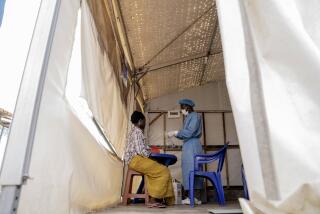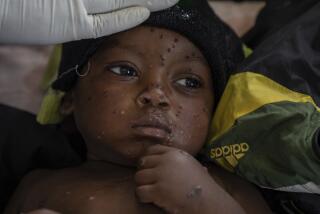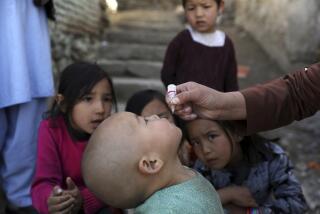Crippling Polio Threat Is Nearly Eradicated in Western Hemisphere : Medicine: There have been eight cases in Colombia and one in Peru in the last year. This may mean that immunization programs are working.
BALTIMORE â Polio, the viral disease that once killed hundreds of U.S. children annually and crippled thousands more, finally may have been nearly eradicated from the Western Hemisphere.
Dr. Donald A. Henderson, a White House adviser on life sciences and former dean of the Johns Hopkins School of Hygiene and Public Health, told a symposium here recently that the last known case of âwildâ polio in the Americas occurred last August in Peru.
The disease, which struck nearly 20,000 children at its peak in the United States 40 years ago, has been virtually eliminated in developed countries, thanks to immunization campaigns begun in the 1950s.
Although only a handful of cases occur in the United States each year in reaction to the oral vaccine, polio outbreaks still hit an estimated 200,000 people worldwide, mostly in Africa and Asia. The World Health Organization has pledged to eradicate the disease by the end of the decade.
Cases in Central and South America have dropped dramatically in the seven years since health officials launched a massive $450-million immunization campaign. Through door-to-door, village-by-village canvassing, nearly 90% of the 11 million children born there every year get three doses of the oral vaccine by their first birthday, health officials say.
That effort has put the disease âon the verge of eradicationâ in this hemisphere, Henderson said during a scientific gathering marking the 75th anniversary of the Hopkins public health school.
âIt looks like the (disease) transmission has stopped, that the virus is done, but you have to be very sure,â said Henderson, who directed an international effort that eradicated smallpox, another deadly epidemic disease, in the 1970s.
An official with the Pan American Health Organization in Washington confirmed that there have been no reported cases of polio in this hemisphere since last Aug. 23, when a 2-year-old boy living northeast of Lima, Peru, was stricken.
The toddler lost the use of one of his legs and needs a crutch to walk, said Dr. Jon Andrus, a physician overseeing polio surveillance for the organization.
The disease will not be officially declared eradicated until three years have passed without a confirmed case, Andrus said, but health officials are âcautiously optimisticâ that they have halted its spread.
There were nine polio cases reported in the Americas last year, Andrus said: the one in Peru and the other eight in Colombia. About 1,000 cases were reported from virtually every Latin and South American country in 1985, the year the Pan Am health group launched its vaccination drive.
The polio eradication campaign demonstrates again the overall effectiveness of vaccines in prevention of disease, Henderson said.
International efforts immunize more than 80% of the 140 million children born worldwide each year against a variety of diseases, including measles and diphtheria. As many as 2.5 million deaths are averted each year in the West as a result.
New vaccines are being developed that may halt the spread of other deadly diseases, like malaria and the human immunodeficiency virus, which leads to acquired immune deficiency syndrome, said Dr. Gordon L. Ada, an Australian microbiologist who spoke at the symposium.
Researchers also are working on new âsuper-vaccinesâ to immunize children against a host of diseases at once, eliminating the need for repeated trips to the doctor.
Researchers are working on more than a dozen vaccines that may prevent the spread of the AIDS virus, Henderson said, and field trials may begin in the next year or so.
President Bush has asked Congress to boost federal immunization spending by $50 million to $390 million, Henderson said, and the Administration has made development of an AIDS vaccine a top research priority.






